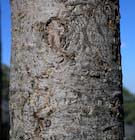
Tree, about 10 m tall, in habitat on Cerro Potosí at 24.8995° N, 100.211° W [C.J. Earle, 2007.02.19].

Tree on Cerro Potosí, still bearing its last cone crop [C.J. Earle, 2007.02.19].

Foliage, upper surface [C.J. Earle, 2007.02.18].

Foliage, lower surface [C.J. Earle, 2007.02.18].

Bark on a 13 cm diameter tree [C.J. Earle, 2007.02.19].

Cones from Cerro Potosí, Nuevo Leon [Jeff Bisbee, 2014.09].

Sun foliage from the Sierra La Marta, Coahuila [Jeff Bisbee, 2014.09].

Conservation Status

Abies vejarii
Martínez (1942)
Common names
Abeto de Vejar [Spanish], Vejar fir.
Taxonomic notes
This is a member of Abies section Grandis. See Abies religiosa for general notes on the Mexican and Mesoamerican firs, including the uncertain placement of A. vejarii. Infraspecific taxa in this species include Abies vejarii Martínez subsp. vejarii var. vejarii; Abies vejarii Martínez subsp. vejarii var. macrocarpa Martínez 1948; and Abies vejarii Martínez subsp. mexicana (Martínez) Farjon (Farjon 1990).
Subsp. mexicana has been the subject of some controversy, described as Abies mexicana Martínez (1942) and still commonly called by that name in Mexico, but reduced to a variety as Abies vejarii Martínez var. mexicana (Martínez) T.S.Liu, assigned to a subspecies by Farjon (1990), and transferred to A. religiosa by Strandby et al. (2009). Rushforth (1987) asserts that it differs from A. vejarii "in foliage arrangement, cones and bark and also in ecology," but whether it warrants treatment at species or subspecies rank remains uncertain.
Description
Trees to 40 m tall and 150 cm dbh, with a broad conical or pyramidal crown and a single straight trunk with horizontally spreading branches. Bark smooth, thin, grey, on older trees becoming scaly, rough and fissured, grey-brown. Branchlets slender, firm, purple-red turning orange-brown, fairly smooth, shallowly grooved, glabrous. Buds globose, 2.5 × 3 mm, very resinous, with persistent keeled bud-scales. Leaves spirally arranged, 10-20(-25) mm long × 1.3-2 mm wide, slightly twisted at base, shallowly grooved above, stomata from few to 10 lines above, in two broad whitish bands below; resin canals 2, marginal, small. Pollen cones lateral, crowded, globose, 5 mm, reddish. Seed cones lateral, erect, ovoid-oblong with obtuse or truncate apex, 6-12 × 4-6 cm, dark purple ripening to dark brown. Bract scales 2.5 cm long, exserted, first erect then recurved in mature cones. Seeds 8-10 mm long with a 15 × 12 mm violet-brown wing (Farjon 1990).
A. vejarii subsp. mexicana has smaller cones (up to 10 cm) with shorter, included bract scales and may have more deeply grooved, weakly pubescent branchets (Farjon 1990). Rushforth (1987) adds that the bark is cracked into small squares, and the branchets are reddish-brown.
Abies vejarii subsp. vejarii var. macrocarpa has larger cones (10-15 × 5-7 cm) than the type variety and has a restricted range, as noted below (Farjon 1990).
Distribution and Ecology
Mexico: SE Coahuila to Nuevo León and W Tamaulipas, in two disjunct areas in the northern part of the Sierra Madre Oriental of N Mexico. It is found in high mountains at (2,000-)2,800-3,300 m elevation; the climate is cool, with dry summers and wet winters. Codominant species include pines, oaks, and Pseudotsuga menziesii subsp. glauca. Abies vejarii ssp. mexicana is restricted to the Sierra de Santa Caterina, which borders the states of Coahuilla and Nuevo León, where it grows at 2,000-3,000 m elevation on north slopes and in steep ravines. Abies vejarii subsp. vejarii var. macrocarpa is restricted to the Mesa de las Tablas of Coahuilla, and on Cerro Potosí in Nuevo León (Farjon 1990).
Hardy to Zone 7 (cold hardiness limit between -17.7°C and -12.2°C) (Bannister and Neuner 2001).
This species is listed as threatened in Mexico under NOM-ECOL-059-94. So is subsp. mexicana
Remarkable Specimens
No data as of 2025.01.21.
Ethnobotany
No data as of 2025.01.21.
Observations
I have only seen it on Cerro Potosí in Nuevo León. Access is relatively easy; the area is a park and a good (if rocky) road climbs from the village of Dieciocho del Marzo to the summit. The area is extremely interesting from the point of view of conifer diversity, having, in addition to Abies vejarii, Abies religiosa, Pinus arizonica, Pinus culminicola, Pinus hartwegii, Pinus nelsonii, Pinus strobiformis, Pseudotsuga menziesii subsp. glauca, and a nearby stand of Pinus greggii.
Remarks
The epithet honors Octavio Vejar Vasquez, Mexico's Minister for Public Education.
Citations
Farjon, Aljos. 1990. Pinaceae: drawings and descriptions of the genera Abies, Cedrus, Pseudolarix, Keteleeria, Nothotsuga, Tsuga, Cathaya, Pseudotsuga, Larix and Picea. Königstein: Koeltz Scientific Books.
Martínez, M. 1942. Tres especies nuevas méxicanas del género Abies. Anales Inst. Biol. Univ. Nac. México 13(2):621-634. Available: UNAM, accessed 2024.01.19.
Strandby, U., K.I. Christensen, and M. Sørensen. 2009. A morphometric study of the Abies religiosa–hickelii–guatemalensis complex (Pinaceae) in Guatemala and Mexico. Plant Systematics and Evolution 280:59-76.
See also







